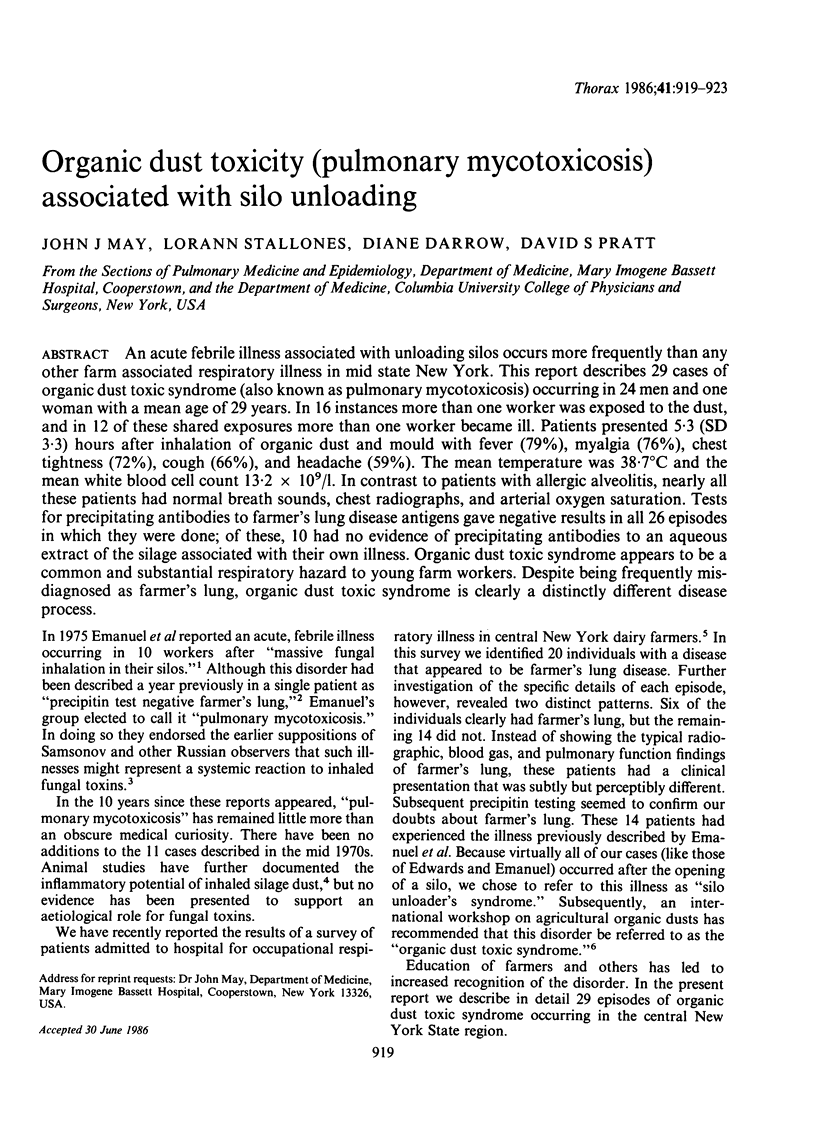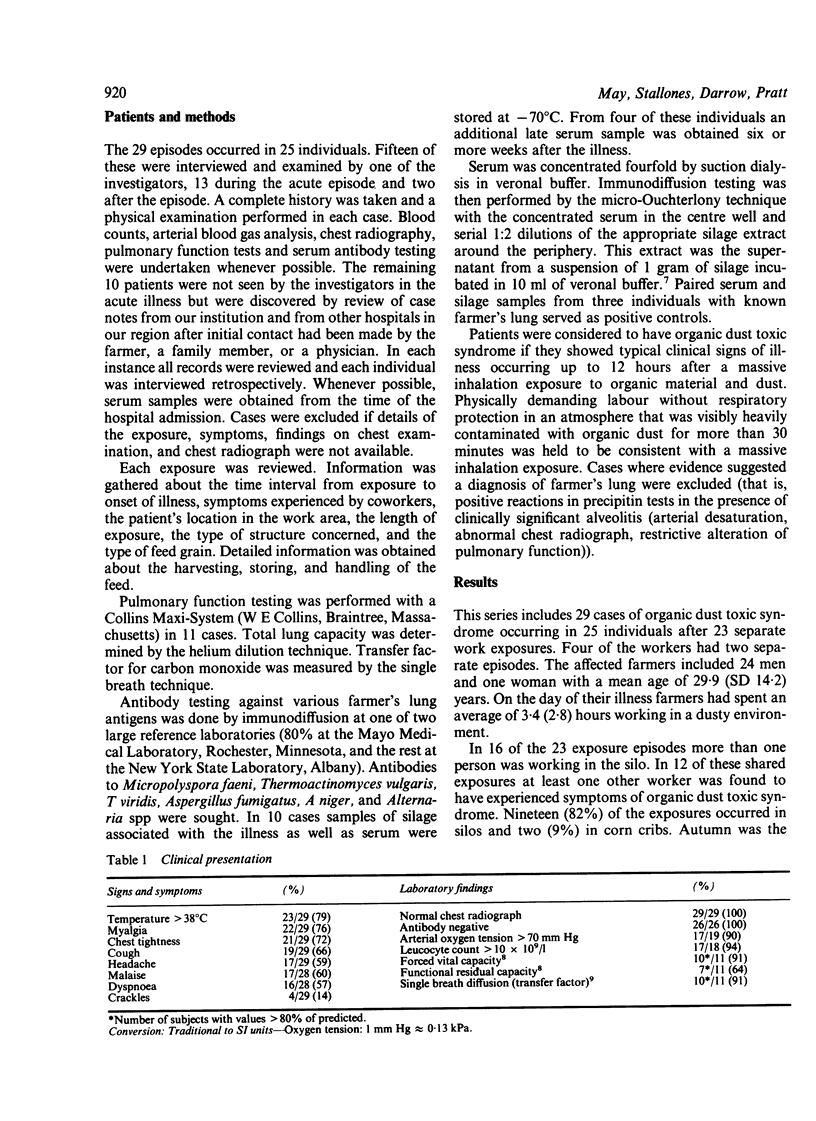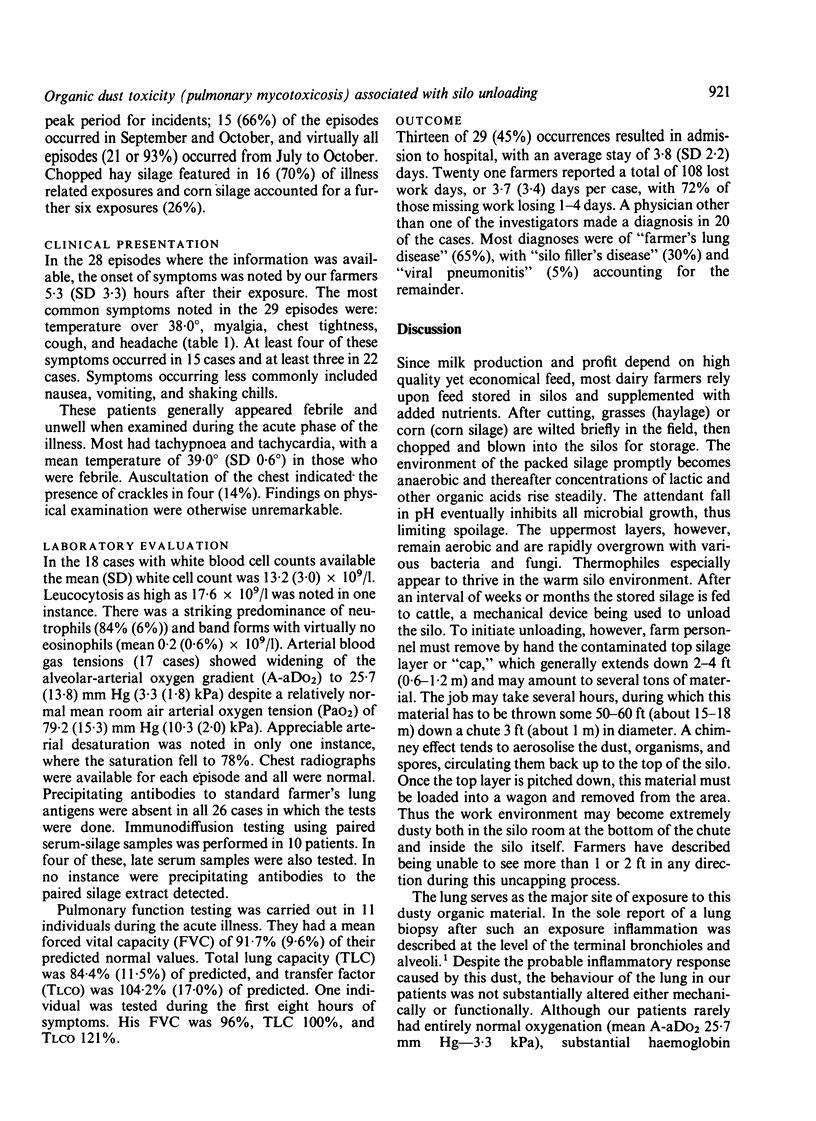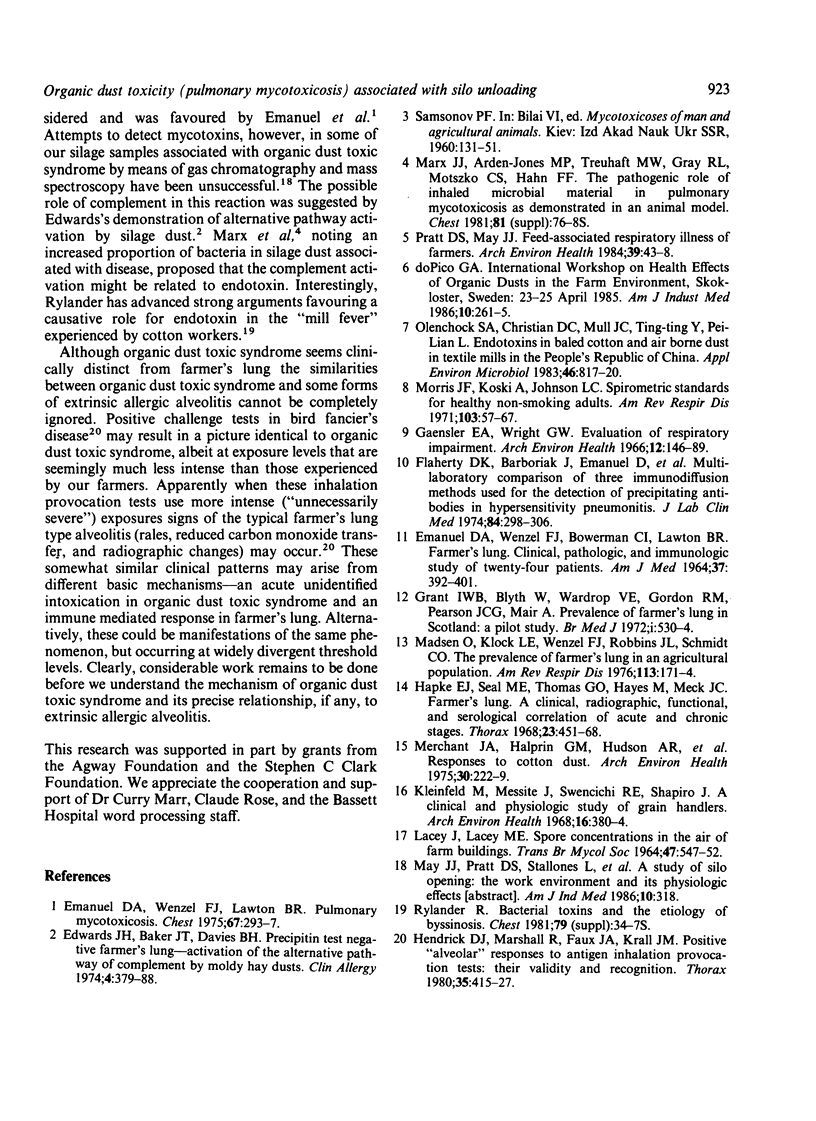Abstract
An acute febrile illness associated with unloading silos occurs more frequently than any other farm associated respiratory illness in mid state New York. This report describes 29 cases of organic dust toxic syndrome (also known as pulmonary mycotoxicosis) occurring in 24 men and one woman with a mean age of 29 years. In 16 instances more than one worker was exposed to the dust, and in 12 of these shared exposures more than one worker became ill. Patients presented 5.3 (SD 3.3) hours after inhalation of organic dust and mould with fever (79%), myalgia (76%), chest tightness (72%), cough (66%), and headache (59%). The mean temperature was 38.7 degrees C and the mean white blood cell count 13.2 X 10(9)/l. In contrast to patients with allergic alveolitis, nearly all these patients had normal breath sounds, chest radiographs, and arterial oxygen saturation. Tests for precipitating antibodies to farmer's lung disease antigens gave negative results in all 26 episodes in which they were done; of these, 10 had no evidence of precipitating antibodies to an aqueous extract of the silage associated with their own illness. Organic dust toxic syndrome appears to be a common and substantial respiratory hazard to young farm workers. Despite being frequently mis-diagnosed as farmer's lung, organic dust toxic syndrome is clearly a distinctly different disease process.
Full text
PDF




Selected References
These references are in PubMed. This may not be the complete list of references from this article.
- EMANUEL D. A., WENZEL F. J., BOWERMAN C. I., LAWTON B. R. FARMER'S LUNG: CLINICAL, PATHOLOGIC AND IMMUNOLOGIC STUDY OF TWENTY-FOUR PATIENTS. Am J Med. 1964 Sep;37:392–401. doi: 10.1016/0002-9343(64)90195-0. [DOI] [PubMed] [Google Scholar]
- Emanuel D. A., Wenzel F. J., Lawton B. R. Pulmonary mycotoxicosis. Chest. 1975 Mar;67(3):293–297. doi: 10.1378/chest.67.3.293. [DOI] [PubMed] [Google Scholar]
- Flaherty D. K., Barboriak J., Emanuel D., Fink J., Marx J., Moore V., Reed C. E., Roberts R. Multilaboratory comparison of three immunodiffusion methods used for the detection of precipitating antibodies in hypersensitivity pneumonitis. J Lab Clin Med. 1974 Aug;84(2):298–306. [PubMed] [Google Scholar]
- Gaensler E. A., Wright G. W. Evaluation of respiratory impairment. Arch Environ Health. 1966 Feb;12(2):146–189. doi: 10.1080/00039896.1966.10664355. [DOI] [PubMed] [Google Scholar]
- Grant I. W., Blyth W., Wardrop V. E., Gordon R. M., Pearson J. C., Mair A. Prevalence of farmer's lung in Scotland: a pilot survey. Br Med J. 1972 Feb 26;1(5799):530–534. doi: 10.1136/bmj.1.5799.530. [DOI] [PMC free article] [PubMed] [Google Scholar]
- Hapke E. J., Seal R. M., Thomas G. O., Hayes M., Meek J. C. Farmer's lung. A clinical, radiographic, functional, and serological correlation of acute and chronic stages. Thorax. 1968 Sep;23(5):451–468. doi: 10.1136/thx.23.5.451. [DOI] [PMC free article] [PubMed] [Google Scholar]
- Hendrick D. J., Marshall R., Faux J. A., Krall J. M. Positive "alveolar" responses to antigen inhalation provocation tests: their validity and recognition. Thorax. 1980 Jun;35(6):415–427. doi: 10.1136/thx.35.6.415. [DOI] [PMC free article] [PubMed] [Google Scholar]
- Kleinfeld M., Messite J., Swencicki R. E., Shapiro J. A clinical and physiologic study of grain handlers. Arch Environ Health. 1968 Mar;16(3):380–384. doi: 10.1080/00039896.1968.10665074. [DOI] [PubMed] [Google Scholar]
- Madsen D., Klock L. E., Wenzel F. J., Robbins J. L., Schmidt C. D. The prevalence of farmer's lung in an agricultural population. Am Rev Respir Dis. 1976 Feb;113(2):171–174. doi: 10.1164/arrd.1976.113.2.171. [DOI] [PubMed] [Google Scholar]
- Marx J. J., Jr, Arden-Jones M. P., Treuhaft M. W., Gray R. L., Motszko C. S., Hahn F. F. The pathogenetic role of inhaled microbial material in pulmonary mycotoxicosis as demonstrated in an animal model. Chest. 1981 Jul;80(1 Suppl):76–78. doi: 10.1378/chest.80.1_supplement.76s. [DOI] [PubMed] [Google Scholar]
- Merchant J. A., Halprin G. M., Hudson A. R., Kilburn K. H., McKenzie W. N., Hurst D. J., Bermazohn P. Responses to cotton dust. Arch Environ Health. 1975 May;30(5):222–229. doi: 10.1080/00039896.1975.10666685. [DOI] [PubMed] [Google Scholar]
- Morris J. F., Koski A., Johnson L. C. Spirometric standards for healthy nonsmoking adults. Am Rev Respir Dis. 1971 Jan;103(1):57–67. doi: 10.1164/arrd.1971.103.1.57. [DOI] [PubMed] [Google Scholar]
- Olenchock S. A., Christiani D. C., Mull J. C., Ye T. T., Lu P. L. Endotoxins in baled cottons and airborne dusts in textile mills in the People's Republic of China. Appl Environ Microbiol. 1983 Oct;46(4):817–820. doi: 10.1128/aem.46.4.817-820.1983. [DOI] [PMC free article] [PubMed] [Google Scholar]
- Pratt D. S., May J. J. Feed-associated respiratory illness in farmers. Arch Environ Health. 1984 Jan-Feb;39(1):43–48. doi: 10.1080/00039896.1984.10545832. [DOI] [PubMed] [Google Scholar]
- doPico G. A. Health effects of organic dusts in the farm environment. Report on diseases. Am J Ind Med. 1986;10(3):261–265. doi: 10.1002/ajim.4700100310. [DOI] [PubMed] [Google Scholar]


